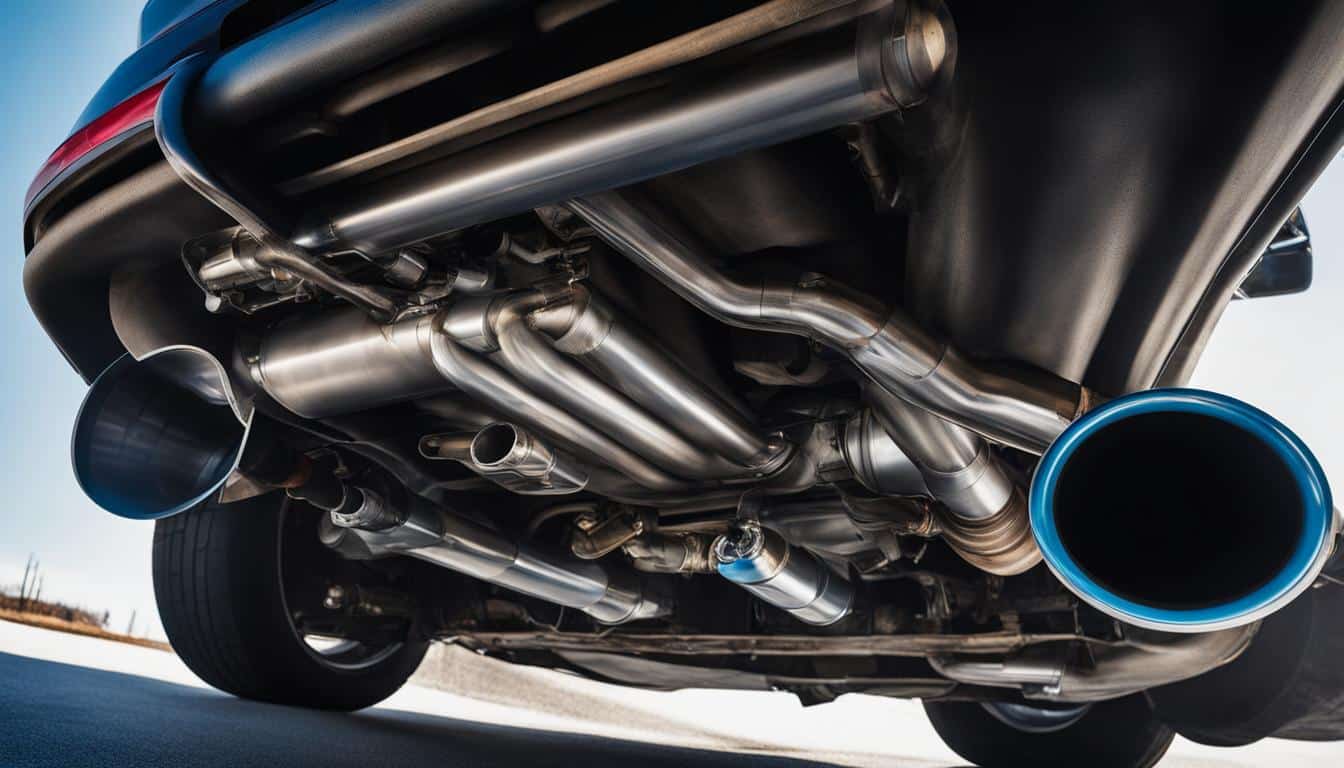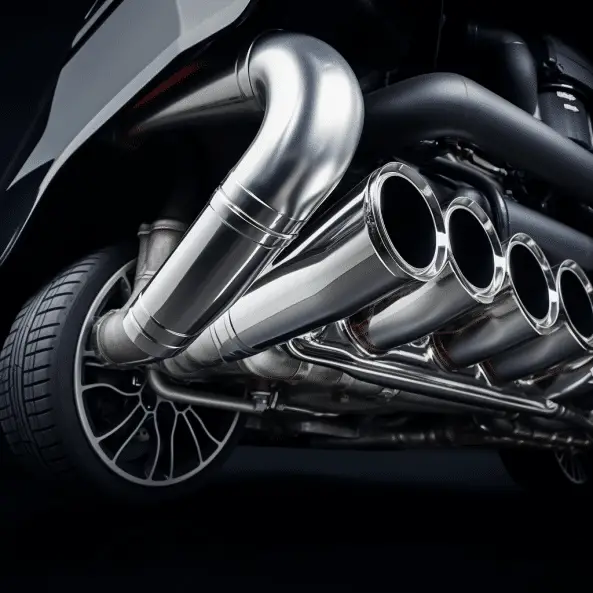
Unveiling the Crucial Functions of Vehicle Exhaust Systems
A vehicle exhaust system is more than just a tailpipe and muffler. It plays a crucial role in directing exhaust fumes away from the engine compartment, reducing emissions, and minimizing noise pollution. The system consists of several parts, including the exhaust manifold, oxygen sensor, catalytic converter, diesel particulate filter, exhaust pipe, and muffler. Each component has a specific function in ensuring the proper functioning of the exhaust system.
Key Takeaways:
- Vehicle exhaust systems are essential for directing fumes away from the engine compartment.
- Exhaust systems help reduce emissions and minimize noise pollution.
- Components such as the exhaust manifold, oxygen sensor, catalytic converter, diesel particulate filter, exhaust pipe, and muffler work together for optimal functionality.
- Understanding the various parts of the exhaust system is crucial for upgrading and maintaining your vehicle.
- Proper functioning of the exhaust system ensures efficient and responsible vehicle operation.
How Car Exhaust Systems Work

Car exhaust systems are a critical component of every vehicle, playing a vital role in ensuring the efficient functioning of the engine and the safety of passengers. Understanding how these systems work can help us appreciate their importance and make informed decisions when it comes to maintenance and upgrades.
During the combustion process, the engine generates powerful explosions that provide the vehicle with the necessary power to move. However, these explosions also produce byproducts in the form of leftover gas containing harmful chemicals such as carbon monoxide, carbon dioxide, nitrogen oxides, and hydrocarbons. If these gases were to enter the cabin, they would pose significant health hazards to the passengers. This is where the car exhaust system comes into play.
“The exhaust system channels the leftover gases away from the vehicle, preventing them from entering the cabin and causing harm. Its primary function is to redirect the exhaust gases away from the engine compartment, effectively venting them to the rear of the vehicle.”
Modern exhaust systems not only ensure the safe disposal of these gases but also play a crucial role in reducing emissions and minimizing noise pollution. Through the collaboration of various components like the exhaust manifold, oxygen sensor, catalytic converter, diesel particulate filter, exhaust pipe, and muffler, the system achieves these objectives seamlessly. Each component performs a specific function, from collecting the exhaust gases to converting harmful pollutants into less harmful substances and reducing noise levels.
With the increasing focus on environmental sustainability, car exhaust systems have become even more critical. By understanding how they work and the role they play in reducing emissions, we can make informed decisions regarding upgrading our exhaust systems to enhance performance and further minimize our impact on the environment.
How Car Exhaust Systems Work:
| Component | Function |
|---|---|
| Exhaust Manifold | Collects exhaust gases from the engine cylinders and directs them to the rest of the system |
| Oxygen Sensor | Measures oxygen levels in the exhaust to optimize fuel-air mixture |
| Catalytic Converter | Converts harmful pollutants into less harmful substances |
| Diesel Particulate Filter | Removes soot or particulate matter from diesel engines |
| Exhaust Pipe | Connects all the components and directs exhaust gases through the system |
| Muffler | Reduces noise and further filters exhaust fumes |
Functions of a Car Exhaust System
A car exhaust system serves three essential functions. Firstly, it directs exhaust fumes from the engine to the rear of the vehicle, preventing them from entering the cabin and potential health hazards. This ensures that passengers are not exposed to harmful gases and particulates that can be present in the exhaust. By directing the fumes away, the exhaust system helps maintain a safe and comfortable driving environment.
Secondly, the car exhaust system plays a crucial role in reducing emissions. It achieves this by eliminating or decreasing the levels of toxic chemicals, such as carbon monoxide and nitrogen oxides, in the exhaust gases. These pollutants can have adverse effects on the environment and human health. The exhaust system, with the help of components like the catalytic converter and diesel particulate filter, works to convert and filter these harmful substances, making the vehicle more environmentally friendly.
Lastly, the car exhaust system minimizes the noise produced by the engine during the fuel combustion process. As the engine generates power through thousands of small explosions, it also creates noise. The exhaust system, particularly the muffler, is designed to reduce this noise, providing a quieter and more comfortable driving experience for both the driver and passengers.
Functions of a Car Exhaust System
- Direct exhaust fumes away from the cabin.
- Reduce emissions of harmful pollutants.
- Minimize engine noise.
Overall, the car exhaust system functions as a critical component for the safe operation of a vehicle. It directs exhaust fumes away from the cabin, reduces emissions to mitigate environmental impact, and minimizes engine noise for a comfortable driving experience. By understanding the functions of a car exhaust system, drivers can appreciate the importance of maintaining and upgrading this essential part of their vehicles.
Car Exhaust System Parts
A car exhaust system is composed of several key components that work together to ensure the proper functioning of the system. These parts include:
- Exhaust Manifold: This component collects the exhaust gases emitted from the engine cylinders and directs them into the rest of the exhaust system.
- Oxygen Sensor: The oxygen sensor measures the oxygen levels in the exhaust gases to optimize the fuel-air mixture, ensuring efficient combustion.
- Catalytic Converter: The catalytic converter plays a crucial role in reducing harmful emissions by converting toxic gases, such as carbon monoxide and nitrogen oxides, into less harmful substances.
- Diesel Particulate Filter: Specifically designed for diesel engines, the diesel particulate filter removes soot or particulate matter from the exhaust gases, improving air quality.
- Exhaust Pipe: The exhaust pipe connects all the components of the exhaust system and channels the gases through the system, directing them away from the vehicle.
- Muffler: The muffler is responsible for reducing noise levels produced by the engine explosions during the combustion process. It also further filters the exhaust fumes before they are released into the atmosphere.
Each of these components plays a vital role in the performance and efficiency of the car’s exhaust system. It is important to ensure that all parts are functioning properly and well-maintained to maximize the lifespan of the system and minimize emissions.
Benefits of Maintaining Exhaust System Parts
Regular maintenance and care of the car’s exhaust system parts offer several benefits:
- Improved Performance: A well-maintained exhaust system allows for optimal engine performance, ensuring that the vehicle runs smoothly and efficiently.
- Reduced Emissions: By keeping the exhaust system components in good condition, harmful emissions can be minimized, contributing to a cleaner and healthier environment.
- Enhanced Fuel Efficiency: A properly functioning exhaust system helps to optimize the fuel-air mixture, resulting in improved fuel efficiency and cost savings.
- Noise Reduction: Well-maintained mufflers and exhaust pipes help to reduce noise pollution, ensuring a quieter and more comfortable driving experience.
Regular inspections and servicing of the car’s exhaust system are essential for identifying any potential issues early on and ensuring that the system operates efficiently. This helps to prevent costly repairs and extends the overall lifespan of the vehicle.
| Exhaust System Part | Function |
|---|---|
| Exhaust Manifold | Collects exhaust gases from the engine cylinders and directs them into the system |
| Oxygen Sensor | Measures oxygen levels in the exhaust gases to optimize the fuel-air mixture |
| Catalytic Converter | Converts harmful pollutants into less harmful substances |
| Diesel Particulate Filter | Removes soot or particulate matter from diesel engines |
| Exhaust Pipe | Connects all the components and directs gases through the system |
| Muffler | Reduces noise and further filters exhaust fumes |
Upgrading Your Vehicle’s Exhaust System
When it comes to upgrading your vehicle’s exhaust system, there are several options to consider that can enhance performance and improve the overall driving experience. One popular upgrade is the installation of an exhaust header. This aftermarket component can increase exhaust scavenging, allowing for better airflow and improved engine efficiency. By optimizing the flow of gases, an exhaust header can help unleash the full potential of your vehicle’s engine.
Another component that can be upgraded is the catalytic converter. Upgrading to a high-performance catalytic converter can not only improve emissions reduction but also enhance the efficiency of the exhaust system. A high-quality catalytic converter can help minimize restrictions and reduce backpressure, allowing for better engine performance.
In addition to upgrading specific components, the choice of piping and the inclusion of a resonator can also have an impact on your vehicle’s exhaust system. Opting for larger diameter piping can help increase exhaust flow, which can contribute to improved performance. The addition of a resonator can help reduce noise levels while maintaining a deep, aggressive exhaust tone.
Lastly, upgrading the muffler can further enhance sound control and performance. A performance-oriented muffler can provide a more aggressive exhaust note while reducing restrictions in the exhaust system. It’s important to choose a muffler that suits your preferences in terms of sound and performance goals.
Conclusion
Understanding vehicle exhaust systems is crucial for vehicle owners looking to enhance performance and reduce emissions. This comprehensive guide has explored the various components and functions of an exhaust system, highlighting its importance in directing exhaust fumes, reducing emissions, and minimizing noise pollution. By upgrading your exhaust system with aftermarket components, such as an exhaust header or catalytic converter, you can further enhance performance and improve the overall driving experience.
Upgrading your exhaust system should be approached with careful consideration of your specific vehicle and performance goals. Selecting the right components, such as piping, resonator, and muffler, can have a significant impact on sound control and performance. Additionally, choosing the appropriate exhaust system parts, such as the exhaust manifold, oxygen sensor, catalytic converter, diesel particulate filter, exhaust pipe, and muffler, is essential for optimal function and emissions reduction.
By taking a comprehensive approach to your vehicle’s exhaust system, you can ensure it operates efficiently and responsibly. Understanding how car exhaust systems work and their impact on vehicle performance and emissions is key to making informed decisions. Upgrading your exhaust system can not only enhance performance but also contribute to reducing harmful emissions, making it a worthwhile investment for any vehicle owner.

FAQ
What is the purpose of a vehicle exhaust system?
A vehicle exhaust system directs exhaust fumes away from the engine compartment, reduces emissions, and minimizes noise pollution.
How does a car exhaust system work?
Car exhaust systems redirect exhaust gases away from the engine compartment and prevent harmful chemicals from entering the cabin.
What are the functions of a car exhaust system?
A car exhaust system directs exhaust fumes, reduces emissions, and minimizes engine noise.
What are the main parts of a car exhaust system?
The main parts of a car exhaust system include the exhaust manifold, oxygen sensor, catalytic converter, diesel particulate filter, exhaust pipe, and muffler.
What are the advantages of upgrading a vehicle’s exhaust system?
Upgrading a vehicle’s exhaust system can improve performance, enhance emissions reduction, and control sound levels.
How can I upgrade my vehicle’s exhaust system?
Upgrading your vehicle’s exhaust system can be done by installing components such as an exhaust header, upgrading the catalytic converter, choosing the right piping and resonator, and selecting a high-performance muffler.
Why is understanding vehicle exhaust systems important?
Understanding vehicle exhaust systems helps vehicle owners make informed decisions about upgrades, improve overall performance, reduce emissions, and enhance the driving experience.
